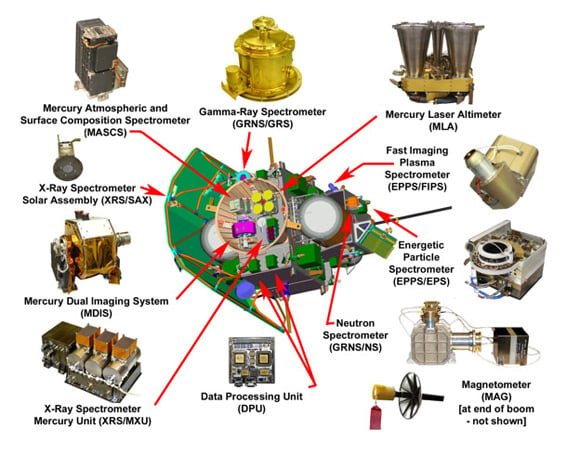This article is more than 1 year old
Don't shoot the Messenger: NASA's suicide probe to punch hole in Mercury
Crash, bang, wallop, what a spacecraft – read our pre-obit
+Vid On April 30, a 16-metre-wide crater will be formed on the surface of Mercury by the hand of Man.
Well, actually, by NASA's MErcury Surface, Space ENvironment, GEochemistry, and Ranging (Messenger) spacecraft, which will end its 11-year mission by piling into the planet's surface at 3.9km per second (8,724 MPH).
The probe is human-kind's first orbiter ever to make it to Mercury; Mariner 10 made three close flybys in 1975. Messenger has made a total of 4,056 orbits around the fastest-moving planet in the Solar System, and there will be 50 more before the probe pierces the surface.
Messenger ran out of its hydrazine and nitrogen tetroxide fuel on April 6, and began to slowly fall towards the strange alien world's surface. NASA engineers managed to work out a way to vent the helium that kept the propellant tanks pressurized to gain extra thrust and keep the probe alive a bit longer.
So far, NASA has downloaded more than 10TB of data from Messenger. The plucky little probe will carry on broadcasting until 10 minutes before its death. We won’t get to see the impact, since it will be on the sunward side of Mercury, but hopefully, when the BepiColombo orbiter arrives at Mercury in nine years, we will get to see Messenger's resting place – and its final contribution to the scientific canon.
Picking out the crash site shouldn't be too hard, we're told.
"Some of brightest deposits on the planet are young impact craters," said Messenger principal investigator Sean Solomon, of Columbia University’s Lamont-Doherty Earth Observatory.
"Space weathering darkens these craters over time, and this seems to operate fastest on Mercury because the level of micrometeorites and dust picked up by the planet is higher. When the BepiColombo probe arrives at Mercury in 2024 it will be looking for the [Messenger] crater, and it will tell us precisely how fast this weathering is going on."
Solomon, who has spent ten years on the Messenger project, said the real science of the mission is now beginning as all the data from the probe is being analyzed. The craft has already upset several key scientific theories about planet formation, revealed a surprising amount of water on Mercury's surface, and forced NASA to develop new technologies that will benefit all mankind.
The strangely volatile life of Mercury
Messenger made headlines around the world in 2012 when NASA confirmed that it had found water near the surface of Mercury at both poles, which Solomon said was the second-most surprising thing discovered on the mission.
The probe spotted frozen pools of water clustered in polar craters that were covered with a dark layer of material about 30cm deep. Based on what the probe could see, the best guess is that this is carboniferous material that arrived on the planet via one or more water-bearing comets or meteorites.
But the biggest surprise for Solomon, and the entire scientific community, was that Mercury is a "volatile-rich planet." The planet is rich in chlorine, potassium, sulphur, and sodium, and the discovery has proved that almost all of our theories about the formation of the Solar System are wrong.

Teardown ... the sensors onboard Messenger
It had been assumed that for a planet that was so close to the Sun, there should be little or none of these volatile chemicals left on Mercury. They shouldn't have been present in large quantities when the planet formed, and they certainly shouldn’t be all over the surface now.
But Messenger detected all four – and in large quantities. It may be that these were deposited on the surface by comets and meteorites, however, Messenger showed that they are all present in volume under the surface too.
Solomon said that the discovery had been a massive problem for astro-boffins who spend their days building complex software models explaining how the early Solar System formed. These simulations had to be junked and redone in light of Messenger's discoveries.
Another big surprise, he said, was Mercury's magnetic field. The Mariner probe noted that the planet did have a magnetic field – something thought unlikely at the time – but Messenger showed that it is a lopsided one.
"Mercury's magnetic field is offset by 20 per cent of the planet radius and we don’t know why," Solomon said. "It's much stronger in the northern hemisphere and that has an effect on charged particles. None of theories for dynamo models predicted this."
Messenger will carry on studying the crust of Mercury right up until the last few minutes of its life to try and solve this mystery. The probe hasn't just taught us about the alien world, but about the technologies we need to get around our Solar City.
